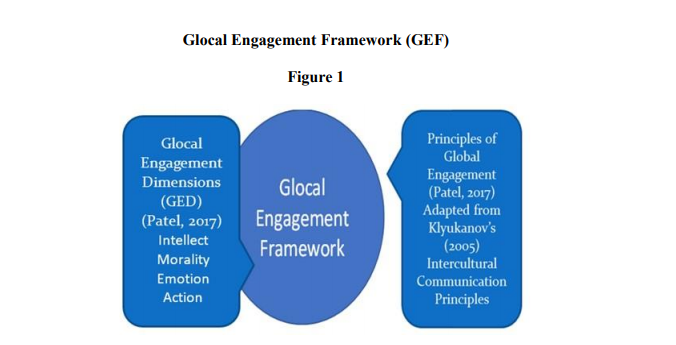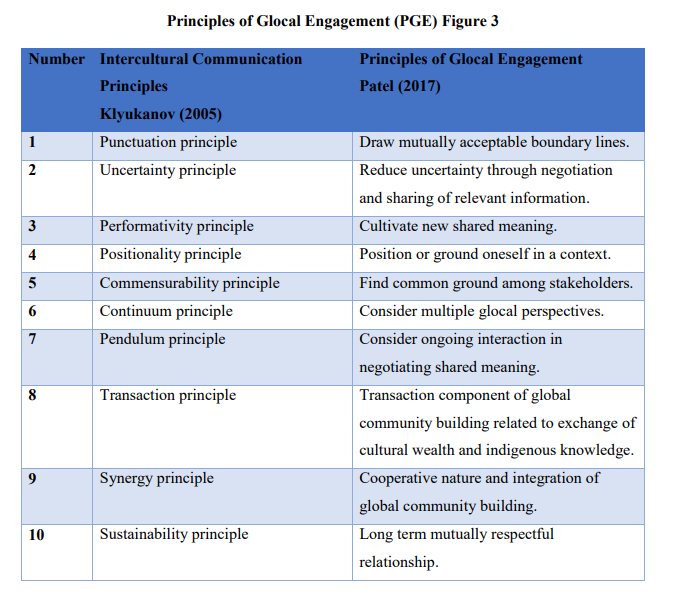Glocalisation refers to the concept of adapting global ideas, processes or products to local environments and contexts. Businesses have been adapting a glocal mindset for years, understanding that international success is best achieved when local perspectives are accounted for and products are adapted to appeal to local cultures.
Organisations should be adopting a glocal mindset not just when it comes to the expansion of their products, but also when it comes to the expansion of their Diversity and Inclusion initiatives. A glocalised Diversity and Inclusion strategy would allow for local cultures to either adapt a centralised strategy to their own culture and values, or to create their own strategy altogether to appeal to the local perspective.
In “Is Glocalisation the future of D&I”, Adrian Hyyrylainen-Trett explores three models that multinational organisations use to address, elevate and celebrate the multicultural and multifaceted nature of their teams.
The first model, “When in Rome” speaks to creating an individual strategy based on the local culture, values and environment. This would be a decentralised approach that gave full autonomy to local regions to create a strategy that fit their local perspectives.
The next model, “Embassy”, speaks to creating a sub-set of the central HQ Strategy. This would be an adaptation of the central strategy based on local culture and values, with some key common values weaved throughout.
The final model, “Advocate”, speaks to a position in which the organisation believes that there are some universal values that supersede local perspectives, such as LGBTQ+ rights or the rights of women. In these instances, organisations would like to use their power to influence behaviour, rather than compromise on what is believed to be objective truth.
While these models have power in enabling an organisation to unify under a global approach, I believe that the rigidity of these models does not allow for real, authentic and diverse innovation. Any diversity strategy will most likely be an amalgamation of aspects of each of these models, or at the very least have room to allow for an agile shift from one model to another.
Rather than wedding an organisation to a particular model, I argue that there is a body of work an organisation needs to undertake to appropriately understand the values, meaning and principles that underpin any diversity work. A framework in this manner would allow an organisation to interrogate their current diversity strategy with a view to build a global strategy with local perspectives.
The “Glocal Engagement Framework” is a framework developed by Fay Patel particularly aimed at glocalisation within a higher education context. Fay describes the Glocalisation Engagement Framework as “a learning and teaching quality paradigm embracing equity, inclusivity and diversity as a sustainable, forward looking international higher education paradigm”.

The Framework aims to encourage communities to find common ground, and to cultivate new shared meaning in order to action change. It especially aims to encourage the “respectful and negotiated exchange of cultural wealth”. The framework is made up of Global Engagement Dimension (GED) and Principles of Global Engagement (PGE). The GED is based on the values that determine the fairness of any actioned outcome, while the PGE is based on Klyukano’s principles of intercultural communication which allow for the successful, fair and just development of a new shared meaning.
The Global Engagement Dimensions aim to ensure that any outcome is fair and just. These dimensions have been developed by Patel and address the core traits that one must hold to create any truly glocal strategy. The Dimensions focus on traits such as Intellect, Morality, Emotion and Action.
Intellect refers to knowledge, education and wisdom. Emotion refers to sensitivity and compassion. Morality refers to integrity, virtue and fairness, and action refers to the desire to change situations.
The Principles of Glocal Engagement refer to the values that underpin a genuine, respectful exchange of cultural wealth. These values have been adapted from Kluykanov’s Intercultural Communication Principles which outlines principles that allow for constructive, continually negotiated and sustainable interaction between people with diverse cultures, traditions and identities.

Fay describes the framework in a higher education context as “a forward thinking, proactive framework. In committing to mutually acceptable norms of engagement (respect, voice and trust, for example), stakeholders engage respectfully in the consensus seeking dialogue.”
I believe we can adapt this framework to work in a Diversity and Inclusion context. A diversity strategy that genuinely seeks to support the global employee group whilst adequately addressing local perspectives will benefit from a strategy that is based on a glocalised framework, i.e. a framework that speaks to the engagement of multiple stakeholders with multiple global perspectives, mutually agreeing on a shared vision.
I will use an example to showcase how the Glocalised Engagement Framework (GEF) can be used in practice. In this instance, the GEF will be used to test whether a strategy is truly glocal in nature. I believe that the GEF can also be used to create a strategy in the first place, to ensure that a glocalised approach is at the very heart of the strategy.
Let’s take international law firm Herbert Smith Freehill’s 2018- 2021 Global Diversity Strategy as our example. Herbert Smith Freehill’s diversity strategy focuses on the inclusion strand of D&I, with the aim to “place the creation of a truly inclusive culture front and centre of our strategy”.
Their Leading for Inclusion strategy takes us through four key pillars of inclusion. These pillars range from Talent to Clients to Innovation and Values, ending with a section on how they will measure success.
Herbert Smith Freehill’s strategy is rooted in values of connectedness, collaboration and leadership. The strategy does reach each of the Glocal Engagement Dimensions as set out by Patel. The strategy clearly displays Intellect by outlining the ‘why’ behind the strategy, such as the benefit of inclusive teams and the centrality of inclusion to reach authentic diversity. The strategy also displays an appreciation of emotion as it discusses the impact of diversity on the psychological safety of individuals within an organisation, “there is a high level of psychological safety within an inclusive organisation”. The strategy’s sense of morality can be seen in their values to connect, collaborate, excel and lead. And their resolve to build and change situations can be seen not only in the creation of the strategy, but in the fact that they have publicly shared their strategy online.
| Glocal Engagement Dimensions (Patel 2017) | Herbert Smith Freehill Diversity Strategy |
| Intellect – Ability to demonstrate knowledge, education and wisdom | Yes – a reference to the “why” behind the strategy and knowledge of the context behind the need for diversity |
| Emotion – Sensitivity, understanding, intuition and compassion | Yes – a discussion of the positive psychological impact of developing an inclusive organisation |
| Morality – Act with integrity, virtue and fairness | Yes – a focus on values to connect, collaborate, excel and lead |
| Action – Resolve to build and change situation | Yes – creation of a strategy which is shared widely online to inspire other organisations |
So far, Herbert Smith Freehill have ticked every box of the Glocal Engaement Dimensions. This is a fantastic start, and their actioned outcomes are much more likely to be fair, inclusive and diversified. However, on greater interrogation, it becomes clear that the strategy Herbert Smith Freehill have created is global rather than glocal in nature. When we run the strategy through the lens of the Principles of Glocal Engagement, it misses some crucial principles that would root a diversity strategy in a glocal context. While the strategy focuses on some brilliant routes to collaboration through networks and client relationship building, encouraging a building of shared meaning and a shared vision, there is little to show for the local contexts in which this global strategy will be carried out.
For example, “Multiple Global Perspectives” (Principle 6) and “Ground[ing] oneself in Context”( Principle 4) are lacking in this strategy, thus firmly positioning this strategy as a global, centralised strategy with little tailored local implementation. There is little information about the make-up of Herbert Smith Freehill’s global team, the local cultures that make up the company, and current diversity data. The strategy, which is at one point referred to as “Global one-firm inclusive culture”, seems firmly rooted in a non-glocalised approach. However, that is not to say that the strategy is not brilliant in many ways. By taking the strategy through the Glocalised Engagement Framework, we can see the individual strands of the strategy that may need a little more work, and the areas that are well thought out and destined for success. The Glocalised Engagement Framework in this manner is a brilliant framework that allows for a nuanced, well-analysed strategy.
The Principles of Glocal Engaement below refer to the stakeholders most involved in the benefits / impact of the Diversity Strategy.
| Principles of Glocal Engagement (Patel 2017) | Herbert Smith Freehill Diversity Strategy |
| 1 – Draw mutually acceptable boundary lines | Yes – developed a governance structure to ensure that there is clear accountability. |
| 2 – Negotiation and sharing of relevant information | Yes – a focus on the role that ERG networks have to increase engagement and share information. |
| 3 – Cultivate new shared meaning | Yes – an established definition of Diversity and Inclusion from their perspective. “Defining what we mean”, ensuring shared meaning. |
| 4 – Position or ground oneself in a context | No – very little information about the context in which HSF have built this strategy, who it will affect, how it will vary in a global context, an appreciation of local nuances. |
| 5 – Find common ground among stakeholders | Yes – a focus on client collaboration and network profiling. |
| 6 – Consider multiple global perspectives | No – little discussion about perspectives from a global nature and the potential impact this might have on the global nature of the strategy. |
| 7 – Consider ongoing interaction in negotiating shared meaning | Yes – working with networks to develop their annual plans based on wider strategy, allowing for local nuance whilst still feeding into wider strategy. |
| 8 – Transaction component of global community building related to exchange of cultural wealth and indigenous knowledge | Yes – found in the ‘Values’ pillar, to connect, collaborate and lead. The aim here is to share cultural wealth via networks and clients. |
| 9 – Cooperative nature and integration of global community building | Yes / No – a focus on collaboration but little discussion of the global nature of community building. |
| 10 – Long term mutually respectful relationship | Yes – a governance and accountability structure in place to ensure that targets are met, and that the strategy rooted in collaboration is followed. |
This example serves to showcase how a Glocalised Engagaement Framework can be used to test the glocal nature of a strategy. It is through this framework that we can understand the nuanced nature of the strategy and can identify the key areas that require further development. A Glocalised Engagement Framework can thus be used to rethink certain aspects of a strategy whilst also celebrating the aspects that are working well.
Organisations that wish to expand their global strategy into authentic, local implementation, should adopt a glocal approach, using the Glocalised Engagement Framework as a route for interrogation and adaptation. As a result, Diversity and Inclusion strategies have the potential to be far-reaching, powerful in their capacity to effect change, and serve to unify organisations through consistent collaboration, negotiation and compassion.




